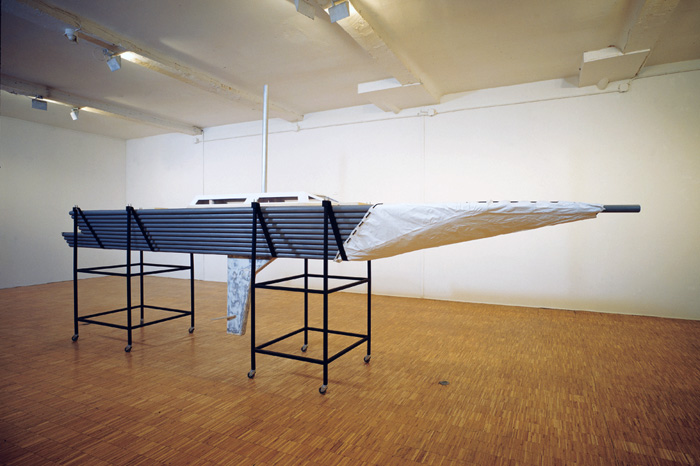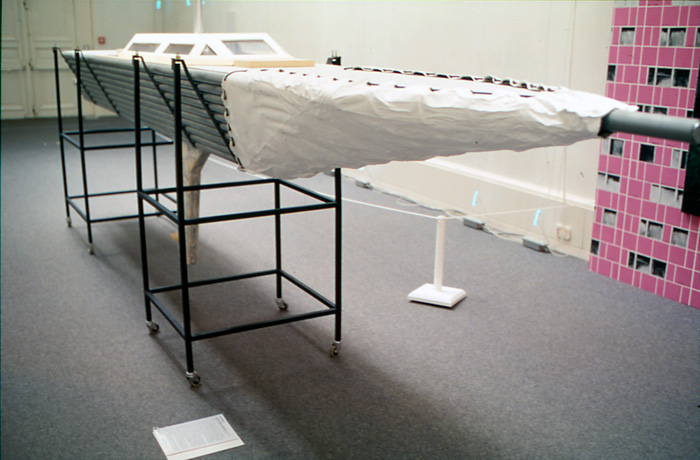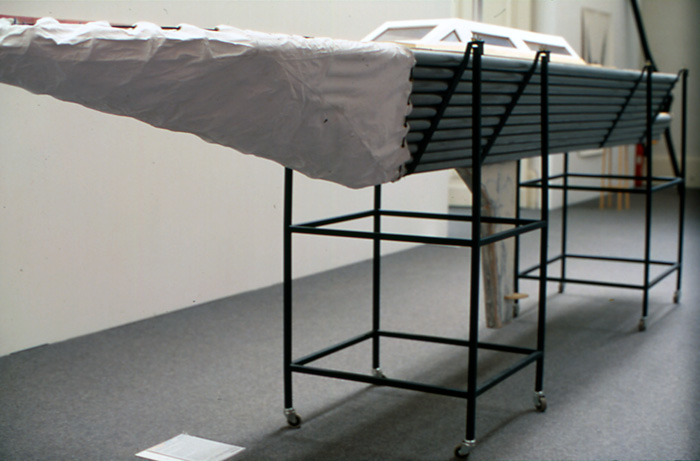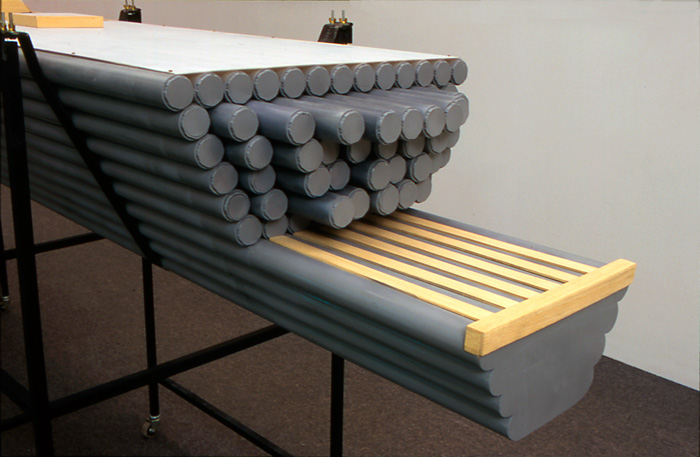 |
Hécatée/Bateau-Mémoire (maquette) ou création de matière à penser 1988-1995
PVC, bois, plastique, nylon, acier, aluminium, 244 x 606 x 70 cm
Collection Frac Provence-Alpes-Côte d'Azur
Vue d'exposition Hécatée au Frac Provence-Alpes-Côte d'Azur, Marseille
Photographie Yves Gallois / Frac PACA
Hecatus/Memory-Boat (model) or the creation of thinking material 1988-1995
PVC, wood, plastic, nylon, steel, aluminum, 244 x 606 x 70 cm
Collection Frac Provence-Alpes-Côte d'Azur
View of the exhibition Hecatus at the Frac Provence-Alpes-Côte d'Azur, Marseille
|
La maquette gigantesque (plus de 6 m hors tout) d’un navire, constituée d’un assemblage de tubes an matière synthétique grise, astis première actualisation d’un projet ambitieux qui marque une nouvelle étape dans l’oeuvre de l’artiste. En effet, ce projet — baptisé Hécatée du nom du géographe grec, qui au V siècle avant notre ère, a conçu les premiers éléments d’une cartographie méditerranéenne —prend une dimension esceptionnelle du fait des implications techniques et économiques qui le déterminent, des objectifs intellectuels, culturels, relationnels qui sont les siens.
Le projet Hécatée, c’est d’abord l'invention d’un bateau destiné dans un premier temps à parcourir la Méditerranée et être à la fois le véhicule et le réceptacle des “substances mèmorielles” que son équipage aura rassemblées. Cet équipage renouvelable devant être formé à partir d’un large éventail de spécialistes de la représentation du monde (géographes, biologistes, astrophysiciens, philosophes...), le bateau deviendra au fur et à mesure de ses pérégrinations le lieu de dépôt des savoirs, des mémoires, des langages qui ont été pratiqués à son bord. Nous retrouvons ici une dialectique du contenant et du contenu chère à l’artiste. La coque du bateau formée de conteneurs cylindriques contiendra les “substances” collectées par son équipage afin de reconstituer les strates de la mémoire d’un nomadisme programmé. A cet égard, Hécatée est structuré comme un vaste conteneur mobile où les “substances mémorielles” sont hiérarchisées an fonction de leur densité et de leur volume matériel les éléments lourds étant répartis dans la carène du navire, tandis qu’à l’intérieur, protégés, seront stockés les documents fragiles. La beauté du projet réside dans la confrontation de la dimension utopique et métaphorique de l’entreprise avec les contingences techniques de as mise an oeuvre. La première étape du travail qui a conduit à la réalisation de la maquette est achevée, Le projet est techniquement viable du double point de vue de sa constructibilité et de ses qualités marines. Le projet Hécatée a déjà commencé à remplir son rôle de cristallisation des énergies, des savoirs et des imaginations.
Jean Marc Réol, in Art Press (extrait) n°215, 1996
The gigantic model of a ship, comprising an assemblage of tubes made of synthetic grey material, represents the first leg of an ambitious project marking a new direction in the artist’s work. As a matter of fact, the project, baptised Hécatée in reference to the Greek geographer who, in the 5th century b.c., conceived the first elements for a Mediterranean map – boasts an exceptional dimension owing to the technical and economic implications that determine it as well as its intellectual, cultural and relational goals.
The Hecatus Project initially entails the invention of a ship destined to travel throughout the Mediterranean, acting as both the vehicle and the vessel for “memorial substances” gathered by its crew. This crew comprised of changing members will bring together specialists on world representation (geographers, biologists, astrophysicians, philosophers…). Over the course of its peregrinations, the ship will gradually become the storage place for the fields of knowledge, memories and languages exercised on board. The dialectic between contents and container cherished by the artist thus reemerges.
Composed of cylindrical containers, the ship’s hull will house the “substances” collected by its crew in order to reconstitute the layers of memory proper to a programmed nomadism. In this respect, Hecatus is structured like a vast mobile container where the “memorial substances” are classified hierarchically according to their material density and volume, the heavy elements being distributed throughout the keelson whereas fragile documents are protected and stored in the ship’s intérieur.
The beauty of the project resides in the confrontation between the endeavor’s utopian and metaphorical dimension and the technical contingencies related to its activation. The first phase of the work that culminated with the construction of the model is now complete. The project is technically viable both regarding both its feasability and marine qualities. The Hecatus Project has already begun filling its role as a crystaliszer of energies, knowledge, and imagination.
Jean Marc Réol, in Art Press (excerpt) n°215, 1996
|
 |
 |
 |
Hécatée/Bateau-Mémoire (maquette) ou création de matière à penser 1988-1995
PVC, bois, plastique, nylon, acier, aluminium, 244 x 606 x 70 cm
Collection Frac Provence-Alpes-Côte d'Azur
Vues de l'exposition Hypothèses de collection : Frac Provence-Alpes-Côte d'Azur au Musée du Luxembourg, Paris
Photographies Marc Domage / Frac PACA
Hecatus/Memory-Boat (model) or the creation of thinking material 1988-1995
PVC, wood, plastic, nylon, steel, aluminum, 244 x 606 x 70 cm
Collection of the Frac Provence-Alpes-Côte d'Azur
Views of the exhibition Hypothèses de collection : Frac Provence-Alpes-Côte
d'Azur au Musée du Luxembourg, Paris
|
Retour |
|
|
|